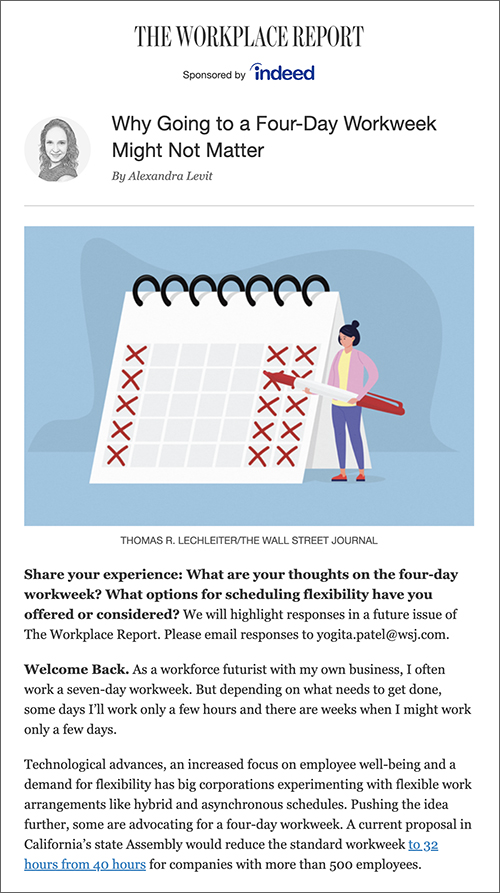 Welcome Back. As a workforce futurist with my own business, I often work a seven-day workweek. But depending on what needs to get done, some days I’ll work only a few hours and there are weeks when I might work only a few days.
Welcome Back. As a workforce futurist with my own business, I often work a seven-day workweek. But depending on what needs to get done, some days I’ll work only a few hours and there are weeks when I might work only a few days.
Technological advances, an increased focus on employee well-being and a demand for flexibility has big corporations experimenting with flexible work arrangements like hybrid and asynchronous schedules. Pushing the idea further, some are advocating for a four-day workweek. A current proposal in California’s state Assembly would reduce the standard workweek to 32 hours from 40 hours for companies with more than 500 employees.
However, many in the HR community doubt that a four-day workweek will take hold on a wide scale. “There would need to be a massive overhaul in business and work/life philosophy in our country for this to work as a general concept,” said Karen Niovitch Davis, chief HR officer at integrated marketing agency Prosek Partners. She thinks a five-day workweek is still essential since business is traditionally conducted Monday through Friday.
Christy Pruitt-Haynes, an HR consultant at NeuroLeadership Institute, thinks that many organizations wouldn’t be able to move to a four-day workweek (or fully asynchronous work) because of the customers they service. “While internal interactions can happen at various times, external client expectations have not caught up and a bit more structure is required,” she said.
Instead of moving to a four-day workweek, some companies have adopted a model where workers are encouraged to find an eight-hour shift that works best for them from within a 14-hour window. “There are core hours–10 a.m. to 3 p.m., usually–where employees need to be available for meetings and clients and won’t be interrupted,” said David Lewis, CEO of HR consultancy OperationsInc and the founder of the think tank HR Roundtable.
But flexible models like this still total 40 hours of work a week, which begs the question: Is a four-day workweek even considered full-time?
For some industries with a high number of overtime exempt positions, the notion that it will take exactly 40 hours in a week to do your job is arbitrary. Mr. Lewis said that full-time work today in these organizations is more related to output than time. “As the competition for talent increases, these companies can allow people to work at a pace that supports workflow.” Depending on your organization and industry, this pace may be closer to 32 hours–or could be up to 60 hours.
To make non-traditional arrangements like the four-day workweek doable, HR leaders should be prepared for inevitable issues. For instance, when everyone is working at the same time for a more extended period, it is easier to chase a colleague down for an answer. Ms. Pruitt-Haynes said the No. 1 resource people forget when moving to non-traditional work schedules is a clear decision-making process or responsibility assignment chart.
Managers should also ensure that employees who work onsite or during “preferred” hours aren’t given priority on more desirable assignments to demonstrate that all work styles are OK and encouraged, according to Ms. Pruitt-Haynes. And, it’s important not to assume that employees think that less in-person time is always better.
Will a four-day workweek catch on in America, or will it go the way of the now obsolete open office trend? It is difficult to envision how this work structure could be widely mandated without broad pushback from business, and in any case, its viability greatly depends on an individual organization’s circumstances.
